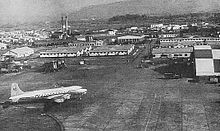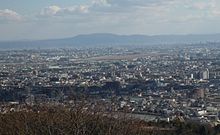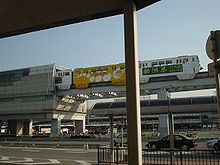- Osaka International Airport
-
Osaka International Airport
Itami International Airport
大阪国際空港
Ōsaka Kokusai Kūkō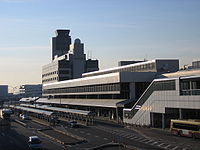
IATA: ITM – ICAO: RJOO Summary Airport type Public Operator Ministry of Land, Infrastructure and Transport (airfield); Osaka International Airport Terminal Co., Ltd. (terminal) Serves Osaka, Kyoto, and Kobe Location Itami, Hyogo Prefecture
Ikeda and Toyonaka, Osaka PrefectureHub for All Nippon Airways
Japan AirlinesElevation AMSL 39 ft / 12 m Coordinates 34°47′04″N 135°26′21″E / 34.78444°N 135.43917°ECoordinates: 34°47′04″N 135°26′21″E / 34.78444°N 135.43917°E Map Location in Japan Runways Direction Length Surface m ft 14R/32L 3,000 9,843 Asphalt concrete 14L/32R 1,828 5,997 Asphalt concrete Statistics (2005) Aircraft Movements 66,259 Passenger Movements 18,948,300 Freight Volume 154,412 t Sources: Japanese AIP at AIS Japan[1] Osaka International Airport (大阪国際空港 Ōsaka Kokusai Kūkō) (IATA: ITM, ICAO: RJOO) or Osaka-Itami International Airport is the primary domestic airport for the Kansai region of Japan, including the major cities of Osaka, Kyoto, and Kobe. It is classified as a first class airport.
The airport is often called Itami Airport (伊丹空港 Itami Kūkō) because most of its land is located in Itami, Hyōgo Prefecture. The terminal complex is located in Toyonaka, Osaka Prefecture, and the only access from the Itami side is via a long tunnel that passes below the runway and apron. A portion of the airport property is in Ikeda, Osaka.
Despite its "international" designation, the airport's scheduled passenger air traffic is entirely domestic. Kansai International Airport (27 mi (43 km) away) took over Osaka's international traffic in 1994 and competes with Itami for domestic traffic. Itami also faces competition from Kobe Airport (16 mi (26 km) away), a smaller domestic airport opened in 2006, nevertheless in FY2006 Itami was Japan's 3rd busiest airport and the Kansai region's busiest.
During 2005, this airport had 66,259 aircraft movements (32 cities). The total number of passengers was 18,948,300. Freight volume was at 154,412 metric tons total.[2]
Contents
History
Itami Airport opened as No. 2 Osaka Airport (第二大阪飛行場 Dai-ni Ōsaka Hikōjō) in 1939. Prior to the opening of Itami, Osaka was served by seaplanes which used an airport at the mouth of the Kizu River. In 1931, the Osaka municipal government drafted plans to construct a new "No. 1 Osaka Airport" near the mouth of the Yamato River, also targeted at seaplanes, but concerns about fog and protests from Kobe-based businesses led the government to build the "No. 2 Airport" for land-based aircraft instead.[3]
Construction began in July 1936 on a 53 ha site. The new airport was primarily used by the Imperial Japanese Army during its early years. U.S. occupation forces took over Osaka Airport after the end of World War II in 1945, expanding it to 221 ha and renaming it Itami Air Base. The airfield was used extensively by US forces during the Korean War.[4] In 1954, Marilyn Monroe and Joe DiMaggio stopped at Itami during their honeymoon, and in 1956, the base was used in the filming of the movie Sayonara.
Itami was renamed Osaka Airport (大阪空港 Ōsaka Kūkō) following its return to Japanese control in March 1959. The Japanese government quickly implemented a plan to expand the airport by an additional 82.5 ha so that it could accommodate jet aircraft. Despite some protests from locals, the plan was approved by the neighboring city assemblies between 1960 and 1961 with strong backing from local business groups, and land was purchased between 1962 and 1964, in part out of the aviation industry's interest in keeping pace with the development of the Tokaido Shinkansen high-speed rail link between Tokyo and Osaka. The main runway was completed in 1970.[4]
In its heyday Itami was served by a variety of major international carriers, including Pan Am, United, British Airways, Air India, Cathay Pacific and Korean Air. Northwest Airlines briefly operated a New York-Itami-Sydney route in the early 1990s, which raised Japanese protest because less than 30% of passengers on the Australia-Japan segment were originating in the U.S.[5]
Political friction
While Japan's economy was growing rapidly, the area around Itami Airport became an increasingly dense residential area for commuters to Osaka.
A number of factors made the airport an intensely-debated political issue in the 1960s and 1970s, among them:
- The introduction of jet aircraft made noise and air pollution a growing concern among locals.
- The United States Armed Forces had rights to use Itami Airport for refueling and maintenance, and frequently sent military aircraft there for overhauls at the ShinMaywa Industries plant there. This activity caused consternation among locals who were opposed to the Vietnam War.
Jet flights at Itami began on June 1, 1964 and triggered complaints by neighboring residents about noise pollution.[4] In addition, eminent domain procedures were used in 1966 to obtain land for the runway expansion at Itami and led to local protests, as had also been the case in the construction of Narita International Airport near Tokyo.[6]
In May 1968, a group of local citizens decided to sue the government for damages related to noise pollution from Itami Airport. The lawsuit was filed in December 1969. The Japanese government concurrently banned takeoffs and landings at Itami between 10:30 PM and 6:30 AM, effective February 1970.[4]
In February 1974, the Osaka District Court issued a qualified ruling in favor of the plaintiffs which limited the scope of their damages. The plaintiffs appealed to the Osaka High Court, which ruled in November 1975 that the plaintiffs were entitled to both a wider scope of damages and an injunction halting flights at the airport between 9 PM and 7 AM. This was a landmark decision in Japanese environmental law as it set a precedent for polluters to be enjoined and to be required to pay damages to victims. However, the state then appealed to the Supreme Court of Japan, which deliberated for almost six years before ruling in 1981 that the High Court injunction was illegal (though the victims remained entitled to damages).[4]
By the mid-1970s, the airport was subject to extensive slot restrictions, with operations limited to 200 jets and 170 propeller aircraft per day, and no takeoffs or landings allowed after 9 PM. These restrictions led the major domestic airlines to adopt more widebody aircraft in ultra-high-density configurations on Itami routes. The introduction of these widebodies caused additional concern among locals who protested the increased pollution and greater dangers in the event of a crash.
Domestic era
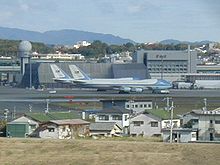 Air Force One aircraft parked at Osaka Airport
Air Force One aircraft parked at Osaka Airport
Because of the political friction surrounding Itami, planners began work in the 1970s to relocate many of its flights to an offshore location. This plan led to the opening of Kansai International Airport in 1994 on an artificial island in Osaka Bay.[6]
There were originally plans to close Itami Airport following the opening of Kansai, but nearby communities opposed such a move for economic reasons, so Itami was retained as a domestic-only airport after Kansai opened in 1994. The only international passenger flights to use Itami since 1994 have been in connection with state visits. Air Force One visited Itami in November 2005, and Chinese premier Wen Jiabao landed at Itami in April 2007.[7] All Nippon Airways retains a large maintenance base at Itami which occasionally services aircraft ferried in from overseas without passengers, and some international cargo flights continue to use the airport as well.
The Japanese government has taken further moves to limit operations at Itami in order to spur development at Kansai and Kobe. Commercial passenger aircraft with more than two engines were banned from Itami effective April 2006, although such aircraft may continue to make ferry flights to and from Itami for maintenance purposes. The government proposed changing Itami's status from first-class airport to second-class airport, which would saddle local governments with one-third of its operating costs; after protests from the surrounding local authorities, the national government withdrew this proposal. The government also proposed banning widebody aircraft from Itami, although this proposal was criticized as unrealistic given the volume of traffic there.
Since July 2008, Osaka Prefecture governor Toru Hashimoto has also been a vocal critic of the airport, arguing that the Chuo Shinkansen maglev line will make much of its domestic role irrelevant, and that its domestic functions should be transferred to Kansai in conjunction with upgraded high-speed access to Kansai from central Osaka. In 2009, Hashimoto proposed closing Itami and converting the site into an "International Campus Freedom City" operating in the English language with 20,000 residents; the governor of Hyogo Prefecture, who advocated the resumption of international service at Itami, criticized the idea as "complete nonsense."[8] Hashimoto later expressed support for Transport Minister Seiji Maehara's plan to maintain Itami with further restrictions on the size of aircraft.[9]
In May 2011, the Diet of Japan passed legislation to form a new Kansai International Airport Corporation using the state's existing equity stake in Kansai Airport and its property holdings at Itami Airport. The move was aimed at offsetting Kansai Airport's debt burden.[10]
Accidents and incidents
- 30 September 1957: Douglas DC-4 JA6011 of Japan Airlines suffered a number one engine failure on takeoff and stalled, crash landing in a rice paddy in Toyonaka. Seven were injured.[11]
- 12 June 1961: Vickers Viscount G-APKJ of All Nippon Airways was damaged beyond economic repair when the starboard undercarriage collapsed following a heavy landing.[12]
Terminals, airlines and destinations
Airlines Destinations Terminal All Nippon Airways Kagoshima, Naha, Tokyo-Haneda, Tokyo-Narita, Nagasaki, Sendai, Sapporo-Chitose
Seasonal: KushiroSouth All Nippon Airways operated by Air Nippon Kumamoto, Miyazaki, Nagasaki, Sendai South All Nippon Airways operated by ANA Wings Fukuoka, Kochi, Matsuyama, Niigata
Seasonal: IwamiSouth All Nippon Airways operated by Ibex Airlines Fukuoka, Fukushima, Oita, Sendai, Tokyo-Narita South Amakusa Airlines Kumamoto North Japan Airlines Naha, Sapporo-Chitose, Tokyo-Haneda, Tokyo-Narita North Japan Airlines operated by J-Air Akita, Aomori, Fukuoka, Iwate-Hanamaki, Kumamoto, Miyazaki, Nagasaki, Niigata, Sapporo-Chitose, Yamagata North Japan Airlines operated by JAL Express Amami-Oshima, Kumamoto, Sendai North Japan Airlines operated by Japan Air Commuter Fukuoka, Izumo, Kagoshima, Matsumoto, Matsuyama, Miyazaki, Niigata, Oita, Oki, Tajima, Tanegashima North Ground transportation
Rail
The only direct rail connection to the airport is the Osaka Monorail, which stops in the northern suburbs of Osaka.
« Service » Osaka Monorail Main Line (11) Terminus - Hotarugaike (12) There have been plans to connect the JR Takarazuka Line and Hankyu Takarazuka Line to Itami Airport, as well as to extend the monorail to central Itami, but these plans have never been realized. Hyōgo Prefecture is currently studying the feasibility of building a separate light rail connection between the airport and central Itami, which would connect to the JR Takarazuka Line and possibly the Hankyu Itami Line.
Bus
A number of scheduled buses run to and from the airport daily.
References
- ^ AIS Japan
- ^ Statistics
- ^ 関西の空港史(20060531)
- ^ a b c d e Shigeto Tsuru, The political economy of the environment: the case of Japan.
- ^ "Japan May Move Against Northwest Airlines," The New York Times, March 12, 1993.
- ^ a b Daniel P. Aldrich, Site Fights: Divisive Facilities and Civil Society in Japan and the West
- ^ 京で一服 友好の舞台 温家宝首相 入洛, Kyoto Shimbun, April 13, 2007.
- ^ Airport wars roil Kansai region, Japan Times
- ^ Osaka governor supportive of idea to reduce Itami airport's role, Associated Press
- ^ 関空・伊丹統合法が成立 1兆円超す負債解消目指す, Asahi Shimbun
- ^ http://ja.wikipedia.org/wiki/%E6%97%A5%E6%9C%AC%E8%88%AA%E7%A9%BA%E9%9B%B2%E4%BB%99%E5%8F%B7%E4%B8%8D%E6%99%82%E7%9D%80%E4%BA%8B%E6%95%85
- ^ "Accident description". Aviation Safety Network. http://aviation-safety.net/database/record.php?id=19610612-2. Retrieved 14 September 2009.
External links
- Osaka International Airport (Japanese)
- Guide to Osaka Itami International Airport (ITM)
- Osaka Airport Transport Company, Limited
Japanese airports First class airports Chūbu Centrair International · Kansai International · Narita International · Osaka International (Itami) · Tokyo International (Haneda)Second class airports Third class airports Aguni · Amami · Aomori · Fukue · Fukui · Fukushima · Hachijojima · Hanamaki · Hateruma · Ibaraki (Hyakuri) · Iejima · Iki · New Ishigaki · Ishigaki · Iwami · Izumo · Kamigoto · Kerama · Kikai · Kitadaito · Kobe · Kōzushima · Kumejima · Matsumoto · Memanbetsu · Minami-Daito · Miyakejima · Miyako · Monbetsu · Nakashibetsu · Nanki-Shirahama · New Tanegashima · Niijima · Noto · Odate-Noshiro · Ojika · Okayama · Oki · Okinoerabu · Okushiri · Oshima · Rebun · Rishiri · Sado · Saga · Shimojishima · Shizuoka · Shonai · Tarama · Tokunoshima · Tottori · Toyama · Tsushima · Yakushima · Yonaguni · YoronOther airports Amakusa · Chofu · Hiroshima-Nishi · Honda · Kasaoka · Kōnan · Komatsu* · Makurazaki · Miho-Yonago* · Misawa Air Base/Misawa Airport* · Nagoya · Oitakenou · Okadama* · Tajima · Teshikaga · Tokushima*
(*: dual military/civilian use)Military only airfields Akeno · Asahikawa · Ashiya · Atsugi · Chitose · Futenma · Gifu · Hachinohe · Hamamatsu · Hōfu · Hyakuri · Iruma · Iwakuni · Kanoya · Matsushima · Metabaru · Iwo Jima · Kadena · Kasumigaura · Kasuminome · Kisarazu · Minami Torishima · Nyutabaru · Ōminato · Ozuki · Shimofusa · Shizuhama · Tachikawa · Tateyama · Tokachi · Tsuiki · Utsunomiya · YokotaHeliports Defunct airports Stations on the Osaka Monorail Main Line Osaka Airport - Hotarugaike - Shibahara - Shōji - Senri-Chūō - Yamada - Bampaku-kinen-kōen - Unobe - Minami Ibaraki - Sawaragi - Settsu - Minami Settsu - Dainichi - Kadoma-shi
Categories:- Osaka Monorail stations
- Closed bases of the United States Air Force in Japan
- Transport in Osaka Prefecture
- Airports in Japan
- Airports established in 1939
Wikimedia Foundation. 2010.


